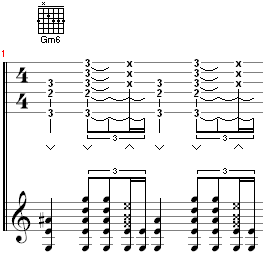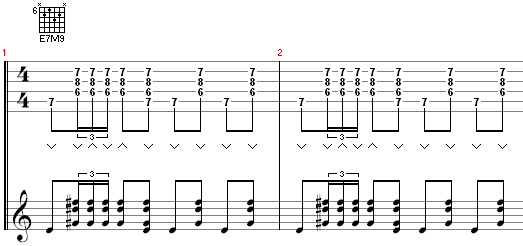Different styles of pompe
Contents
Straight dry pompe
Some rhythm guitar players like Stéphane Wrembel or Yayo and Fanto Reinhardt prefer to play a very dry and percussive pompe.
Beat 1 : the right hand falls down on the lower strings merely with the weight of the hand and the forearm, the left hand frets the chord; Beat 2 : the right hand goes back up higher above the strings to prepare beat 3, the left hand completely mutes the strings; Beat 3 : the right hand "slaps" the strings with a fast downwards rotative movement of the wrist, the left hand mutes the chord immediately after having very briefly fretted it, in order to give a percussive effect (hard to feel at the beginning). Caution: do not hit the strings too strongly, the pick must merely brush the strings very quickly; Beat 4 : the right hand goes back up without touching the strings, just above the lower E string.
Fast standard pompe (> 140 bpm)
The right hand's movement is not so different from the basic pompe excepted that downstrokes must be particularly well synchronised between the wrist rotation and the downward forearm movement. The left hand mutes the strings but this time only on the fourth beat. Ideally, the bass notes should "purr", in other words the bass E and A strings should be let ring. Only the other four strings should be muted if possible.
Example The Black Eyes 156bpm
Pompe for ballads
Not all Manouche musics need a swinging accompaniment. Some songs like "Nuages" on the contrary need a very cool accompaniment. This kind of straight pompe is easy since it's only about playing each beat with downstrokes and letting the right hand litterally fall down quite quickly on the strings to sort of sound like a snare drum. Volume must be adapted to the melody but usually it is quite low, walking the fine line between downstroke speed and volume. The pompist can let the strings ring like on the following little video or let the strings ring and mute them with the left hand right before strumming the next beat.
Tzigan pompe
Tzigan pompe movement is a sequence of a unique bass note followed by the chord's high strings. All beats are downstrokes. The purpose is to simulate a double bass playing a note on the beat, and a guitar that plays the chords on the backbeats. This movement must really be worked out as it should be played at many tempos, sometimes very fast.
Side View:
Czardas example:
Waltz pompe
To play the waltz, all you need to know is count until three: 1-2-3 1-2-3. The accompaniment of waltzes can be similar to the binary shuffled accompaniment excepted that beats 3- and 4- of standard pompe are repeated. The waltz pompe can also be very basic in which case, when the hand comes back up, strings are no strummed. The basic version can also be enriched with a swinged upstroke just before the first beat. Variations are possible to highlight specific beats: measure can be divided in sixths and all beats can be strummed down and up and while we let the strings ring (which sounds closer to the French java than a waltz by the way).
bossa pompe
Bossa in Manouche style is done in four regular beats, that is they are not swinged. The left hand frets the chords on all beats excepted on the third. The right hand does a down-up-down-up movement where all strings are picked. The first beat is played at a very low volume or is not even played at all. The second beat is played at a medium volume. The third beat is percussive with a strong volume : all strings are plucked with a downstroke while the left hand mutes them. The fourth beat is just like the second.
Another more elaborated way o play bossa is shown on the following film. Since it's a bit complex to explain this with written words, the best is probably to cast an eye on the film and to try and integrate this rhythm.
Bolero pompe
Manouche bolero was made famous with Django's "Troublant Bolero". It's played on a 4-beat measure and alternates bass and chords like this: basse (downstroke), light chord roulé in 16ths triplet (down-up-down-up) that ends on the second beat, then chord, bass, chord, bass, chord (all downstrokes). Chords can be let ringing (the way I prefer), or they can be muted for a staccato effect. To have an idea of the rendition, you can look at the following video.
example
Voir aussi:The Pompe






